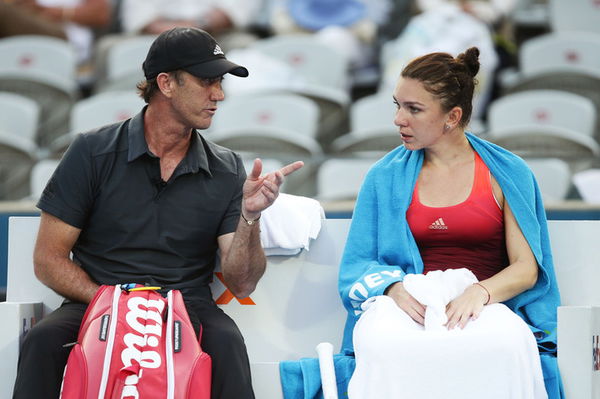

Since WTA introduced on-court coaching back in 2009, talks have been going on about- if it should be included within all departments of the sport. Tennis has always been an individualistic sport, and although there is an entire team working behind the curtains, the player has to do it all by himself during the matches. There is probably no other sport where the coach or his team does not contribute to the ongoing proceedings. The topic of on-court coaching has received mixed reviews, with some of the players calling it a step forward in the sport, while others have been skeptical about it. WTA has introduced on-court coaching in its tournaments; however, it is yet to be implemented at the majors.
Rules of on-court coaching
The rules of the on-court coaching would be such, that if the player is on the side of his/her player’s box, the team can have a conversation with the player between the points. If the player is on the other side, sign language can be used to get the message across. In WTA, the rules allow a player to call a designated coach to court one time per set or during an opponent’s medical break. Conversations via microphones and headsets have also been introduced as an idea and have been tried out at a few select tournaments. The US open also incorporated it last year during the qualifiers and is looking to take a step forward by doing it in the main rounds as well. We look at some of the aspects that on-court coaching might bring into our sport.
ADVERTISEMENT
Article continues below this ad

via Imago
Steve Simon the CEO of WTA thinks on-court coaching is the future of tennis.
Novak Djokovic in favor of the rule
The CEO of WTA says he has received positive feedback and will continue implementing the rule in the near future. He believes that sign language had already been going on before on-court coaching was introduced to the sport. “The on-court coaching has been positive. I want to look at it further,” he said during an interview with the Times. “There are some great personalities among the coaches that could be good for our sport.” He also added “The fact is there is coaching. They all have coaches, and that’s been the question for years; are they coaching from the box or aren’t they? I think coaching is something the sport needs to embrace, it’s part of the story.” Novak Djokovic is another who has taken the on-court coaching as a positive influence on the sport. “When the WTA introduced on-court coaching, many ATP players were not really positive about it. I thought it was a good move for the sport,” he said. “I mean, we’re probably one of the only, maybe [the] only global sport that doesn’t use coaching during the play. Even golf, individual sport, you have caddies that you communicate with throughout the entire course.”
ADVERTISEMENT
Article continues below this ad
Why is on-court coaching bad for the sport?
Meanwhile, there are others who are skeptical about it, and have expressed their concerns. Lindsay Davenport, former WTA player and the current head coach for Madison Keys said it is unethical to televise the personal conversations of the players in tough situations. “In theory it sounds great,” Davenport said. “Go out there and help them with tactics. But we’ve seen over the last few years that it is not always about that. These are personal moments now that we have no business being a part of. It’s turning into a bit of a circus now. There are no clear rules, there are so many matches where the mic is not being used. Then we get pieces of players not handling it well.” This came after an on-court incident with Spanish player Garbine Muguruza, who was almost on the verge of tears as she sat down at the change of ends. “Interesting that she was almost in tears, trying to apologize,” Davenport said. “The whole thing was uncomfortable. I don’t know, I think they have to rethink this. This coaching stuff, with the mics, it does not reflect well on the players the majority of the time. It’s not going out there and talking X’s and O’s all the time and maybe the WTA needs to think about shielding some of these players from visits like that.”

via Imago
The incident with Muguruza was controversial as she refused to fight back back from 0-3 down
Roger Federer has also voiced his concerns about the whole issue. He thinks that most of the players do not have the resources for a good coaching team, and that it would be unfair that only the players who could afford a good coaching team get the benefits of the rule. “I’m not all for it,” he said. “I find it kind of cool that in tennis, you know, you’re sort of on your own out there. Not everybody has the same amount of resources for coaching, as well. So I’m not sure if it’s that beneficial. But, you know, might be interesting for some people to see. I know that some parts of the world, coaching at junior level and all that stuff is totally normal, that the coaches and the players speak. He also added-“I’m sure it’s not going to make that much of a difference because I’m sure there’s hand signs going on as we speak … It doesn’t take much to understand that message. I’m not really for it.”
ADVERTISEMENT
Article continues below this ad
On-court coaching was introduced as an idea to benefit the players; however, many believe it is an idea that has been pushed into the sport by the television channel owners and executives, to increase their ratings. As we all know, the TV owners love some drama and spice on screen, because of a simple reason – it sells! If the idea to improve the quality of tennis being played, was the only reason that on-court coaching was being introduced into the sport, there should be no mics allowed during the conversation or the audio must be cut out. However, the CEO of WTA Steve Simon, who seems to have struck a lucrative deal with the TV channels and the analysts, doesn’t look like he is going to back away from this. Mary Carillo, an authoritative Tennis Channel analyst, thinks it has now turned into a drama channel. She thinks that tennis should preserve its legacy, and remain an individual sport. “So many of these changeovers are all about, ‘You’ll be okay. Don’t worry.’ Then the woman says, ‘I can’t hold my serve. I don’t know what I’m doing out there’-she said. She also added-“Why didn’t all this [preparation] happen on the practice court? Coaches are supposed to teach players how to problem-solve. I feel sorry for a lot of the coaches, putting up with this nonsense. If you can’t figure out a way to win, then you’re supposed to lose.”
It is still a matter of debate and many flaws do exist in the current regime. Simply comparing it with other sports and concluding that coaching is a significant part of the sporting world does not suffice. We need a much more rigid structure and a set of guidelines if at all we wish to preserve the privacy of the players as well as the legacy of the sport. The authorities need to be reminded that it is not just their business that is at stake here; it is the career and life of the players that is being affected. It would be a game changing scenario if on-court coaching goes on to gain mass popularity, and will completely change the meaning of why tennis stood out for being an individual sport for so long.
ADVERTISEMENT
ADVERTISEMENT
ADVERTISEMENT
ADVERTISEMENT

